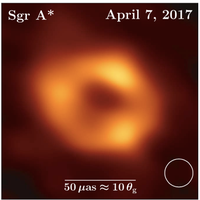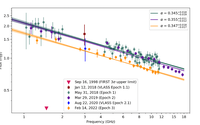Time Domain Studies and Fundamental Physics
NRAO facilities provide unique and powerful windows on transient and variable cosmic phenomena, as well as incisive probes of the most extreme physical processes in the Universe.

The VLBA produced an important measurement of the absolute position of SgrA* this year (Xu et al. 2022), improving the astrometric accuracy to about 0.5 mas, about an order of magnitude better than previous measurements. Also measured was a much-improved proper motion of SgrA*, found to be -3.152±0.011 and -5.586±0.006 mas/year in the easterly and northerly directions, respectively. These measurements are crucial for future studies of general relativistic effects on stellar orbits in the vicinity of SgrA*.
The VLASS completed its second epoch of observations in February 2022. It continues to provide unique insights into the nature of transient radio sources. One recent highlight is the discovery of a candidate extragalactic emerging pulsar wind nebula, VT 1137-0337 (Figure 2; Dong et al. 2022). This was identified by comparing VLASS Epoch 1 to the earlier Faint Images of the Radio Sky at Twenty-cm (FIRST) survey, Subsequent follow-up showed that it is a flat-spectrum radio source in a dwarf starburst galaxy that is now slowly fading, making it an excellent candidate for a newly emerged pulsar wind nebula.
A recent highlight from non-transient applications of VLASS is the combined use of VLASS and the southern Rapid ASKAP (Australian Square Kilometer Array Pathfinder) Continuum Survey (RACS) to measure the dipole produced by the motion of the Milky Way relative to the cosmic background. In contrast to some previous studies, this joint VLASS/RACS study showed results consistent with those obtained by measuring the dipole in the Cosmic Microwave Background (CMB) with the Planck satellite (Darling, 2022, ApJL, 931, 14).
Betelgeuse (𝛂 Orionis) is the closest red supergiant, on the verge of a supernovae explosion. The star is variable on yearly timescales. In early 2020, the star faded to an historically low brightness. This dimming may be due to dust formation in a major mass loss event driven by photospheric convection, or unusual photospheric cooling. VLA 7mm and 1.3cm observations just prior to the dimming find a gas temperature of 2270 K at twice the optical photospheric radius, about 500 K cooler than previous measurements (Matthews & Dupree 2022, ApJ, 934, 131). No giant convective cells were seen, but the observed radio photosphere is inconsistent with a uniform disk, but has large-scale, ring-like structure. The results are consistent with the passage of a major shock wave through the outer atmosphere, possibly driven by large-scale mass ejection.
Large programs at the VLA and VLBA continue to explore the new window of time domain astronomy in a broad range of physical regimes. These include programs to identify electro-magnetic counterparts to gravitational wave sources discovered by LIGO, and to determine arc-second positions of Fast Radio Bursts (FRB) and monitor repeating FRBs. The VLA participates in the Nanohertz pulsar monitoring program to discover the gravitational wave background from the Big Bang, while the Monitoring Of Jets in Active galactic nuclei with VLBA Experiments (MOJAVE) program continues to set the standard for monitoring the temporal evolution of milliarcsecond structure in powerful relativistic radio jets on decadal timescales.




Connect with NRAO